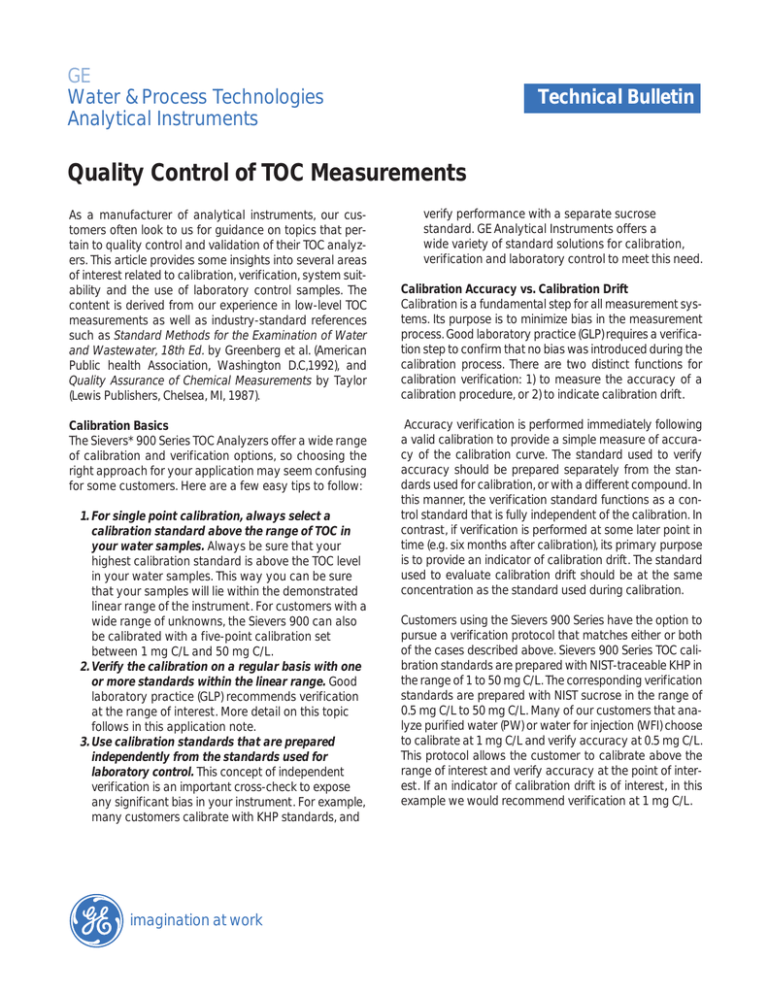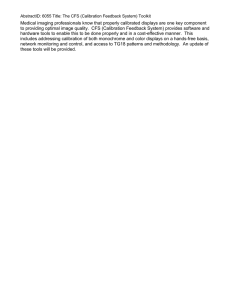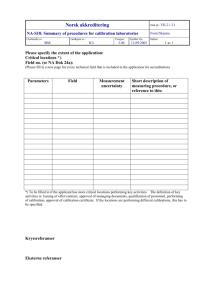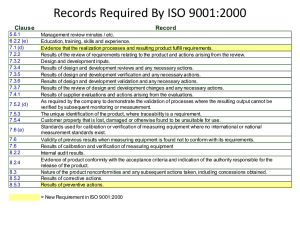
GE
Water & Process Technologies
Analytical Instruments
Technical Bulletin
Quality Control of TOC Measurements
As a manufacturer of analytical instruments, our customers often look to us for guidance on topics that pertain to quality control and validation of their TOC analyzers. This article provides some insights into several areas
of interest related to calibration, verification, system suitability and the use of laboratory control samples. The
content is derived from our experience in low-level TOC
measurements as well as industry-standard references
such as Standard Methods for the Examination of Water
and Wastewater, 18th Ed. by Greenberg et al. (American
Public health Association, Washington D.C,1992), and
Quality Assurance of Chemical Measurements by Taylor
(Lewis Publishers, Chelsea, MI, 1987).
Calibration Basics
The Sievers* 900 Series TOC Analyzers offer a wide range
of calibration and verification options, so choosing the
right approach for your application may seem confusing
for some customers. Here are a few easy tips to follow:
1. For single point calibration, always select a
calibration standard above the range of TOC in
your water samples. Always be sure that your
highest calibration standard is above the TOC level
in your water samples. This way you can be sure
that your samples will lie within the demonstrated
linear range of the instrument. For customers with a
wide range of unknowns, the Sievers 900 can also
be calibrated with a five-point calibration set
between 1 mg C/L and 50 mg C/L.
2. Verify the calibration on a regular basis with one
or more standards within the linear range. Good
laboratory practice (GLP) recommends verification
at the range of interest. More detail on this topic
follows in this application note.
3. Use calibration standards that are prepared
independently from the standards used for
laboratory control. This concept of independent
verification is an important cross-check to expose
any significant bias in your instrument. For example,
many customers calibrate with KHP standards, and
imagination at work
verify performance with a separate sucrose
standard. GE Analytical Instruments offers a
wide variety of standard solutions for calibration,
verification and laboratory control to meet this need.
Calibration Accuracy vs. Calibration Drift
Calibration is a fundamental step for all measurement systems. Its purpose is to minimize bias in the measurement
process. Good laboratory practice (GLP) requires a verification step to confirm that no bias was introduced during the
calibration process. There are two distinct functions for
calibration verification: 1) to measure the accuracy of a
calibration procedure, or 2) to indicate calibration drift.
Accuracy verification is performed immediately following
a valid calibration to provide a simple measure of accuracy of the calibration curve. The standard used to verify
accuracy should be prepared separately from the standards used for calibration, or with a different compound. In
this manner, the verification standard functions as a control standard that is fully independent of the calibration. In
contrast, if verification is performed at some later point in
time (e.g. six months after calibration), its primary purpose
is to provide an indicator of calibration drift. The standard
used to evaluate calibration drift should be at the same
concentration as the standard used during calibration.
Customers using the Sievers 900 Series have the option to
pursue a verification protocol that matches either or both
of the cases described above. Sievers 900 Series TOC calibration standards are prepared with NIST-traceable KHP in
the range of 1 to 50 mg C/L. The corresponding verification
standards are prepared with NIST sucrose in the range of
0.5 mg C/L to 50 mg C/L. Many of our customers that analyze purified water (PW) or water for injection (WFI) choose
to calibrate at 1 mg C/L and verify accuracy at 0.5 mg C/L.
This protocol allows the customer to calibrate above the
range of interest and verify accuracy at the point of interest. If an indicator of calibration drift is of interest, in this
example we would recommend verification at 1 mg C/L.
How Often Should I Test System Suitability?
Generating valid analytical data requires more than a
high quality instrument. In fact, it requires a well-controlled measurement system that consists of each of the
following four factors:
•
•
•
•
Competent and well-trained personnel
Adherence to a standard operating procedure (SOP)
Validated and well-maintained instruments
Traceable reference materials
The current USP Chapter <643> and EP Method <2.2.44>
TOC regulations require that each TOC analyzer be calibrated according to manufacturers’ recommendations
and that the suitability of each analyzer is demonstrated
periodically. Unfortunately, the USP and EP specifications
do not explain how often the system suitability test (SST)
should be performed. The answer involves two basic and
opposing considerations:
• The risk associated with the system being out
of tolerance
• The cost to demonstrate that the system is
within tolerance
Several factors underpin these two considerations, and they
should be evaluated as they pertain to your own facility.
1. What are the risks associated with failing SST?
How does a failure affect the facility?
2. What is the level of experience of the personnel
performing the measurement? Are the operators
sufficiently skilled and trained to extend the
period between SST?
3. Does the measurement system pass the test on a
consistent basis? Is the measurement system stable
and reliable for an extended period of time?
4. Is there an industry trend or corporate guidance
to follow? Will auditors accept a schedule that is
different from the norm?
5. How much does is cost to perform SST?
How Do I Test System Suitability?
The suitability of the TOC analyzer is determined by testing three solutions: a blank (Rw), a 0.5 mg C/L sucrose (Rs),
and a 0.5 mg C/L of 1,4-benzoquinone. The response efficiency (RE) is calculated as follows:
RE = 100[(Rss-Rw)/(Rs-Rw)]
The analyzer is determined to be suitable if 85%<RE<115%.
When a TOC analyzer is first installed, we recommend performing SST on a frequent basis to document the performance of the whole measurement system (i.e. people,
process, instrument, and standards). Many customers
choose to run SST daily or weekly for a period of half a year
or more. Control charts are often used to establish mean
performance, warning limits and control limits based on
real-world data. At some point after the initial evaluation
period, management can evaluate the data that has been
collected and then select the appropriate frequency for
on-going SST. This approach creates confidence that the
decision is well-balanced between the costs of performing
frequent SST and the risk of being out of tolerance.
The Importance of Laboratory Control Standards
Laboratory control standards (LCS) are a common means
to demonstrate that a measurement system is in control,
especially in highly regulated industries such as pharmaceuticals and municipal drinking water. LCS are commonly analyzed with every batch of samples. The control
standard should lie in the same concentration range as
the actual samples or at a specific concentration of interest (e.g. 0.5 mg C/L for WFI testing).
Certified, NIST-traceable standards from an outside supplier are preferred as they will provide the most rigorous
means to challenge the measurement system. If internally prepared standards are used for routine quality control, we recommend periodic use of an externally supplied certified reference material verification. For example, some customers choose to prepare their own solutions for daily check standards, but they rely on Sievers
to provide certified reference materials for weekly system suitability testing. A two-tiered approach like this is a
good balance when budgets are limited.
* Trademark of General Electric Company; may be registered in one or more countries.
For more information, visit www.GEinstruments.com. Find a sales partner near you through the “Contact Us” Section.
USA
GE Analytical Instruments
6060 Spine Road
Boulder, CO 80301-3687 USA
T +1 800 255 6964
T +1 303 444 2009
F +1 303 444 9543
info@geinstruments.com
www.geinstruments.com
Europe
Unit 3 Mercury Way
Mercury Park Estate
Trafford Park
Manchester, UK M41 7LY
T +44 (0) 161 866 9337
F +44 (0) 161 866 9630
generaluk.instruments@ge.com
©2005, General Electric Company. All rights reserved.
300 00110 Rev A
MC05-195



